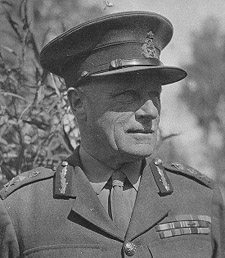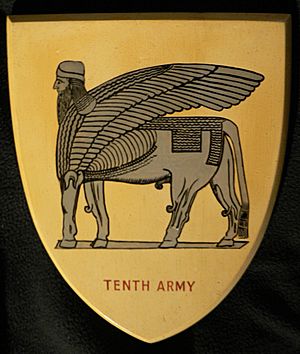Edward Quinan facts for kids
Quick facts for kids
Sir Edward Pellew Quinan
|
|
|---|---|

General Sir Edward Quinan
|
|
| Nickname(s) | "Quinan the Terror" |
| Born | 9 January 1885 Calcutta, India |
| Died | 13 November 1960 (aged 75) London, United Kingdom |
| Allegiance | |
| Service/ |
|
| Years of service | 1905–1943 |
| Rank | General |
| Service number | 181447 |
| Commands held | North Western Army (1943) Tenth Army (1942–43) Iraqforce (1941–42) Western Independent District (Baluchistan and Sind) (1938–41) 9th (Jhansi) Brigade (1934–38) 3rd Battalion 8th Punjab Regiment (1930–32) |
| Battles/wars | First World War North West Frontier Second World War Invasion of Iran |
| Awards | Knight Commander of the Order of the Bath Knight Commander of the Order of the Indian Empire Distinguished Service Order Officer of the Order of the British Empire Mentioned in Despatches |
General Sir Edward Pellew Quinan (9 January 1885 – 13 November 1960) was an important British Army commander during the Second World War. Early in his career, he served in the Indian Army in places like Afghanistan and Waziristan. These areas were on the North West Frontier of the Indian Empire, during the time of the British Raj.
During the First World War, he fought with Indian Army troops in France and Mesopotamia, where he was injured. In the Second World War, General Quinan led British and Indian Army forces in several key battles. These included the Anglo-Iraqi War, the Syria–Lebanon campaign, and the Anglo-Soviet invasion of Iran. He stayed in the Middle East until 1943. Then, he returned to India to command the North West Army. He retired later that year due to health reasons.
Contents
Early Life and First Steps in the Army
Edward Quinan was born in Calcutta, India, on January 9, 1885. His family had roots in both England and Ireland. Sadly, his father passed away when Edward was only ten years old. His mother later remarried, but Edward was raised in Dublin, Ireland, by his grandparents and aunts.
In 1903, he joined the Royal Military College, Sandhurst. This was a famous training school for army officers. He became a second lieutenant on January 9, 1904. A year later, in March 1905, he officially joined the Indian Army. He was promoted to lieutenant in April 1906.
Adventures on the Frontier
Before the First World War, Quinan saw action on the North West Frontier. This was a challenging area of the British Indian Empire. He became a captain on January 9, 1913.
During the First World War, he fought in France and Mesopotamia. He was involved in battles like Neuve Chapelle and Loos. He also took part in the attempt to help troops stuck in the Siege of Kut al Amara. He was wounded during a battle at Beit Aisa.
After the war, he returned to India and the Frontier. He worked as a staff officer during the 1919 Third Anglo-Afghan War. He also served in the Waziristan campaign. Once, while flying a reconnaissance mission, his plane crashed. Luckily, he was not hurt! He later wrote the official history of the Waziristan campaign. Military experts still consider it a great example of a campaign history. He received an award, the Officer of the Order of the British Empire, for his excellent work during this campaign.
Leading the Way: Between Wars
In 1920, Quinan attended the Indian Army Staff College in Quetta. This college is now in Pakistan. He worked in Meerut from 1923 to 1926. After more training in 1927, he joined the 3rd Battalion of the 8th Punjab Regiment.
By 1930, he was in charge of this battalion. He was also chosen to attend the Imperial Defence College. This was a sign that he was seen as someone who could lead at a very high level. While he was in command in Jhansi in 1930, the famous British pilot Amy Johnson had an unexpected landing. She landed her plane, a Gypsy Moth, on the parade ground during her flight from London to Australia. Quinan helped her get her plane fixed.
In 1933, as a colonel, he became an instructor at the Staff College in Quetta. Some famous military leaders, like Auchinleck and Montgomery, were also there around that time. He then went back to Jhansi to lead the 9th (Jhansi) Brigade.
In 1936, he was appointed as an Aide-de-camp to King Edward VIII. He also received another award, the Companion of the Order of the Bath. He was sent to Dacca to help fight against groups seeking Indian independence. In 1937, he led his troops in a campaign against the Faqir of Ipi in Waziristan. For his bravery, he received the Distinguished Service Order. He was promoted to major-general at the end of 1937. However, in March 1938, he had to take time off due to high blood pressure. He recovered and was declared fit for duty in July 1938. He then took command of the Western Independent District.
World War II: Commander in the Middle East
General Quinan spent the first part of the Second World War on the North West Frontier. In March 1941, he was promoted to lieutenant-general. He met with General Sir Archibald Wavell in Cairo. Quinan was then sent to lead the Indian Army Corps in a landing at Basra, Iraq. He became the commander of British Troops in Iraq, known as Iraqforce.
At that time, the government in Iraq was friendly with Germany. They tried to take over the RAF base at Habbaniya and force the British to leave. During the short Anglo-Iraqi War, Quinan's forces invaded from the south. With support from British troops from Trans-Jordan, they removed the pro-German Iraqi government. A new government, friendly to Britain, was put in place.
Quinan then became the commander of the 10th Army in Persia and Iraq. German planes had used bases in Syria to help the Iraqis. So, an operation was planned to invade Syria from Palestine. Quinan's troops in Iraq helped. The goal was to replace the French government in Syria and Lebanon, which was allied with Germany, with a Free French one. This operation was successful.
Later in 1941, Quinan planned and carried out the invasion of Persia (now Iran). The main reasons for this were to protect the supply routes to the Soviet Union and to secure British oil facilities in Abadan. Reza Pahlavi, the leader of Iran, was thought to be pro-German. So, he was removed from power and replaced by his son, Mohammad Reza Pahlavi.
Quinan's command, which became the Tenth Army in February 1942, grew larger. This was because German forces were moving into the Soviet Union and seemed like a threat. By the end of 1942, he commanded eight divisions and two brigades. He also had Polish prisoners of war, released by the Russians, forming a new Polish Corps.
He was knighted in 1942 and received the Knight Commander of the Order of the Indian Empire. In August 1942, he was promoted to a full general.
The German threat lessened after their defeat at Stalingrad. Because of this, Quinan's command began to shrink. By mid-1943, a large army headquarters was no longer needed. The Tenth Army HQ was closed.
Later Career and Legacy
In April 1943, Quinan left the Middle East. He was appointed commander of the North Western Army in India. On November 16, 1943, he retired for medical reasons. His high blood pressure problem had returned. He then went back to Britain.
In November 1945, he was appointed as the Colonel of the 8th Punjab Regiment. In 1946, he received another honor, becoming a Knight Commander of the Order of the Bath. He retired to Barrington, Somerset, and passed away on November 13, 1960.
What Made Him Special?
General Quinan was known for paying very close attention to details. His obituary in The Times newspaper mentioned this. It said he "astonished, and sometimes appalled his subordinates by his meticulous attention to the duties of the smallest units under his command." This means he cared about every little part of his army's work, even the smallest tasks.
|




